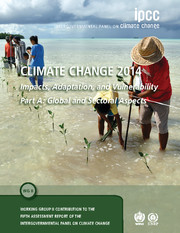 Climate Change 2014 – Impacts, Adaptation and Vulnerability: Part A: Global and Sectoral Aspects
Climate Change 2014 – Impacts, Adaptation and Vulnerability: Part A: Global and Sectoral Aspects Book contents
- Frontmatter
- Contents
- Foreword, Preface, and Dedication
- Summary for Policymakers
- Technical Summary
- Cross-Chapter Boxes
- Chapters 1-20
- Chapter 1 Point of Departure
- Chapter 2 Foundations for Decision Making
- Chapter 3 Freshwater Resources
- Chapter 4 Terrestrial and Inland Water Systems
- Chapter 5 Coastal Systems and Low-Lying Areas
- Chapter 6 Ocean Systems
- Chapter 7 Food Security and Food Production Systems
- Chapter 8 Urban Areas
- Chapter 9 Rural Areas
- Chapter 10 Key Economic Sectors and Services
- Chapter 11 Human Health: Impacts, Adaptation, and Co-Benefits
- Chapter 12 Human Security
- Chapter 13 Livelihoods and Poverty
- Chapter 14 Adaptation Needs and Options
- Chapter 15 Adaptation Planning and Implementation
- Chapter 16 Adaptation Opportunities, Constraints, and Limits
- Chapter 17 Economics of Adaptation
- Chapter 18 Detection and Attribution of Observed Impacts
- Chapter 19 Emergent Risks and Key Vulnerabilities
Chapter 6 - Ocean Systems
Published online by Cambridge University Press: 05 January 2015
- Frontmatter
- Contents
- Foreword, Preface, and Dedication
- Summary for Policymakers
- Technical Summary
- Cross-Chapter Boxes
- Chapters 1-20
- Chapter 1 Point of Departure
- Chapter 2 Foundations for Decision Making
- Chapter 3 Freshwater Resources
- Chapter 4 Terrestrial and Inland Water Systems
- Chapter 5 Coastal Systems and Low-Lying Areas
- Chapter 6 Ocean Systems
- Chapter 7 Food Security and Food Production Systems
- Chapter 8 Urban Areas
- Chapter 9 Rural Areas
- Chapter 10 Key Economic Sectors and Services
- Chapter 11 Human Health: Impacts, Adaptation, and Co-Benefits
- Chapter 12 Human Security
- Chapter 13 Livelihoods and Poverty
- Chapter 14 Adaptation Needs and Options
- Chapter 15 Adaptation Planning and Implementation
- Chapter 16 Adaptation Opportunities, Constraints, and Limits
- Chapter 17 Economics of Adaptation
- Chapter 18 Detection and Attribution of Observed Impacts
- Chapter 19 Emergent Risks and Key Vulnerabilities
Summary
6.1. Introduction: Point of Departure, Observations, and Projections
The oceans cover about 71% of Earth's surface to an average depth of 3700 m. Their importance for life on Earth, including humans, is vast (FAQ 6.1). Marine habitats display natural variability on various spatial and temporal scales but a dearth of long-term observational data from the vast open oceans limits our understanding of the causes and ecological consequences of this variability. The available information indicates that climate controls ocean temperatures, chemistry, circulation, upper ocean stratification, nutrient supply, and sunlight exposure. These drivers affect marine ecosystems through direct effects on organisms, amplified by their changing interactions with other species. Food webs are modified by changes in phytoplankton growth and the availability of live organisms or their decomposing bodies, that is, debris or dissolved organic matter, as food to (chemo-)heterotrophs (organisms gaining energy by feeding on organic matter). Organismal responses lead to changes in biogeochemical processes, such as the carbon cycle, and in biological diversity and the services the oceans provide.
Some impacts of climate change on marine ecosystems and their services were addressed in the IPCC Fourth Assessment Report (AR4): WGII Chapters 4 to 6 (ecosystems, food, coastal areas), and regional chapters, for example, 15 (polar regions) and 16 (small islands). The ecosystem assessment in WGII AR4 Chapter 4 focused on terrestrial, coastal, and marine systems, their properties, goods, and services. It emphasized the difficulty in assessing future ecosystem responses as a result of ecosystem complexity, different vulnerabilities of species, and ecosystem-specific, critical thresholds associated with nonlinear responses to environmental change. Focusing on terrestrial ecosystems, WGII AR4 Chapter 4 concluded that more than 2°C to 3°C warming above preindustrial levels causes high extinction risks to 20 to 30% of present-day species (medium confidence), paralleled by substantial changes in ecosystem structure and functioning (high confidence). The authors projected that a wide range of planktonic and benthic calcifiers will be impacted by ocean warming (very high confidence) and acidification (medium confidence), particularly in the Southern Ocean. They characterized sea ice and coral reef biomes as highly vulnerable.
Information
- Type
- Chapter
- Information
- Climate Change 2014 – Impacts, Adaptation and Vulnerability: Part A: Global and Sectoral AspectsWorking Group II Contribution to the IPCC Fifth Assessment Report, pp. 411 - 484Publisher: Cambridge University PressPrint publication year: 2014
Accessibility standard: Unknown
Why this information is here
This section outlines the accessibility features of this content - including support for screen readers, full keyboard navigation and high-contrast display options. This may not be relevant for you.Accessibility Information
- 4
- Cited by